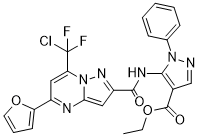Physicochemical Properties
| Molecular Formula | C24H17CLF2N6O4 |
| Molecular Weight | 526.88 |
| Exact Mass | 526.096 |
| Elemental Analysis | C, 54.71; H, 3.25; Cl, 6.73; F, 7.21; N, 15.95; O, 12.15 |
| CAS # | 944547-46-0 |
| Related CAS # | 944547-46-0 |
| PubChem CID | 1045147 |
| Appearance | Light yellow to yellow solid powder |
| Density | 1.5±0.1 g/cm3 |
| Index of Refraction | 1.680 |
| LogP | 5.52 |
| Hydrogen Bond Donor Count | 1 |
| Hydrogen Bond Acceptor Count | 9 |
| Rotatable Bond Count | 8 |
| Heavy Atom Count | 37 |
| Complexity | 837 |
| Defined Atom Stereocenter Count | 0 |
| SMILES | O=C(C1=C(NC(C2C=C3N=C(C4=CC=CO4)C=C(N3N=2)C(Cl)(F)F)=O)N(C2C=CC=CC=2)N=C1)OCC |
| InChi Key | YPPNLSKYXDXQGD-UHFFFAOYSA-N |
| InChi Code | InChI=1S/C24H17ClF2N6O4/c1-2-36-23(35)15-13-28-32(14-7-4-3-5-8-14)21(15)30-22(34)17-12-20-29-16(18-9-6-10-37-18)11-19(24(25,26)27)33(20)31-17/h3-13H,2H2,1H3,(H,30,34) |
| Chemical Name | ethyl 5-[[7-[chloro(difluoro)methyl]-5-(furan-2-yl)pyrazolo[1,5-a]pyrimidine-2-carbonyl]amino]-1-phenylpyrazole-4-carboxylate |
| Synonyms | Mycro3; Mycro-3; Mycro 3 |
| HS Tariff Code | 2934.99.9001 |
| Storage |
Powder-20°C 3 years 4°C 2 years In solvent -80°C 6 months -20°C 1 month |
| Shipping Condition | Room temperature (This product is stable at ambient temperature for a few days during ordinary shipping and time spent in Customs) |
Biological Activity
| Targets | AP-1; c-Myc |
| ln Vitro | In whole-cell experiments, Mycro 3 is a strong and sensitive c-Myc dye that exhibits a mild inhibitory effect against activator protein 1 (AP-1). The dye-reactive properties of Mycro 3 are identical to those of its predecessor. Mycro 3 prevents Myc and Max from coordinating with the c-Myc dye. Mycro 3 is a highly specific inhibitor of DNA binding and c-Myc/Max dimerization [1]. With IC50s of 0.25 and 9.0 μM for cells with intact Myc alleles and Myc-null cells, respectively, Mycro 3 shows excellent promise [2]. |
| ln Vivo | In patients with pancreatic ductal adenocarcinoma (PDA), Mycro 3 (100 mg/kg; oral; taken daily for two months) significantly reduces cell swelling, enlarges the pancreas, and causes considerable shrinking. Significant differences were also observed in the growth of Mycro 3-treated NOD/SCID tumors containing orthotopic or heterotopic human pancreatic xenografts [2]. |
| Animal Protocol |
Animal/Disease Models: Moribund Pdx1-cre/KRAS* mice with pancreatic ductal adenocarcinoma (PDA) [2] Doses: 100 mg/kg Route of Administration: Oral; one time/day for two months Experimental Results: Prolonged survival . Mycro 3 administration was stopped after two months, and the mice survived for another month. |
| References |
[1]. Small molecules targeting c-Myc oncogene: promising anti-cancer therapeutics. Int J Biol Sci. 2014 Sep 13;10(10):1084-96. [2]. Therapeutic effects of an anti-Myc drug on mouse pancreatic cancer. J Natl Cancer Inst. 2014 Oct 11;106(12):dju320. |
Solubility Data
| Solubility (In Vitro) | DMSO: ~100 mg/mL (~189.8 mM) |
| Solubility (In Vivo) |
Solubility in Formulation 1: 2.5 mg/mL (4.74 mM) in 10% DMSO + 90% Corn Oil (add these co-solvents sequentially from left to right, and one by one), clear solution; with sonication. For example, if 1 mL of working solution is to be prepared, you can add 100 μL of 25.0 mg/mL clear DMSO stock solution to 900 μL of corn oil and mix evenly. (Please use freshly prepared in vivo formulations for optimal results.) |
| Preparing Stock Solutions | 1 mg | 5 mg | 10 mg | |
| 1 mM | 1.8980 mL | 9.4898 mL | 18.9797 mL | |
| 5 mM | 0.3796 mL | 1.8980 mL | 3.7959 mL | |
| 10 mM | 0.1898 mL | 0.9490 mL | 1.8980 mL |
